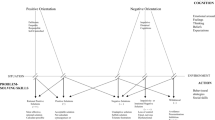Abstract
The present study examined the validity of the Social Problem-Solving Inventory (SPSI) and SPSI—Revised in differentiating 65 high-suicidal from 63 depressed, low-suicidal college students. Results from multivariate analyses indicated overall differences in problem-solving between these two groups as measured by the SPSI but not by the SPSI-R. Further examination of these differences revealed the high-suicidal group was different in problem-solving orientation, rather than problem-solving skills, compared to the depressed, low-suicidal group. However, when depression was statistically controlled in hierarchical regression analyses, none of the problem-solving measures predicted group membership. The superiority of the SPSI to the SPSI-R in differentiating these two groups appears to be accounted for by the elimination of 28 items in the revised version, many of which measure orientation to problem-solving. Also explored was the possibility that objective measures of problem-solving provide a better prediction of adjustment than do self-report measures.
Similar content being viewed by others
References
Beck, A., Kovacs, M., & Weissman, A. (1979). Assessment of suicidal ideation: The Scale for Suicide Ideators.Journal of Consulting and Clinical Psychology, 47, 343–352.
Bonner, R. L., & Rich, A. R. (1987). Concurrent validity of a stress-vulnerability model of suicidal ideation and behavior: A follow-up study.Suicide and Life-Threatening Behavior, 17, 265–271.
Bonner, R. L., & Rich, A. R. (1988). A prospective investigation of suicidal ideation in college students: A test of a model.Suicide and Life-Threatening Behavior, 18, 245–258.
Clum, G. A., & Febbraro, G. A. R. (1994). Stress, social support, and problem-solving appraisal/skills: Prediction of suicide severity within a college sample.Journal of Psychopathology and Behavioral Assessment, 16, 69–83.
Clum, G. A., & Yang, B. (1995). Additional support for the reliability and validity of the Modified Scale for Suicide Ideation.Psychological Assessment, 7, 122–125.
Clum, G. A., Patsiokas, A., & Luscomb, R. (1979). Empirically based comprehensive treatment program for parasuicide.Journal of Consulting and Clinical Psychology, 47, 937–945.
Clum, G. A., Canfield, D., Van Arsdel, M. V., & Yang, B. (1996).An expanded etiological model for suicide behavior in adolescents: Evidence for its specificity relative to depression (manuscript submitted for publication).
Dixon, W. A., Heppner, P. P., & Anderson, W. P. (1991). Problem-solving appraisal, stress, hopelessness, and suicide ideation in a college population.Journal of Counseling Psychology, 38, 51–56.
D'Zurilla, T. J. (1986).Problem-solving therapy: A social competence approach to clinical intervention. New York: Springer.
D'Zurilla, T. J., & Goldfried, M. R. (1971). Problem-solving and behavior modification.Journal of Abnormal Psychology, 88, 107–126.
D'Zurilla, T. J., & Nezu, A. M. (1982). Social problem-solving in adults. In P. C. Kendall (Ed.).Advances in cognitive-behavioral research and therapy, Vol. 1. New York: Academic Press.
D'Zurilla, T. J., & Nezu, A. M. (1990). Development and preliminary evaluation of the social problem-solving inventory.Psychological Assessment: A Journal of Consulting and Clinical Psychology, 2, 156–163.
D'Zurilla, T. J., Nezu, A. M., & Maydeu-Olivares, A. M. (1994). A revision of the SPSI based on factor-analytic methods: An integration of theory and data. Poster presented at the 28th Annual convention of the AABT, San Diego, CA, Nov.
Heppner, P. P., & Petersen, C. H. (1982). The development and implications of a personal problem-solving inventory.Journal of Counseling Psychology 29, 66–75.
Krupnick, J., Shea, T., & Elken, I. (1986). Generalizability of treatment studies using solicited patients.Journal of Consulting and Clinical Psychology, 54, 68–78.
Linehan, P. P., & Camper, P., Chiles, J. A., Strosahl, K., & Shearin, E. (1987). Interpersonal problem-solving inventory.Cognitive Therapy and Research, 11, 1–12.
Marx, E. M., Williams, J. M. G., & Claridge, G. C. (1992). Depression and social problem solving.Journal of Abnormal Psychology, 101, 78–86.
Maydeu-Olivares, A., & D'Zurilla, T. J. (1996). A factor-analytic study of the Social Problem Solving Inventory: An integration of theory and data.Cognitive Therapy and Research (in press).
Miller, I. W., Norman, W. H., Bishop, S. B., & Dow, M. G. (1986). The Modified Scale for Suicidal Ideation: Reliability and validity.Journal of Consulting and Clinical Psychology, 5, 724–725.
Nezu, A. M., & D'Zurilla, T. J. (1989). Social problem solving and negative affective conditions. In P. C. Kendall & D. Watson (Eds.),Anxiety and depression: Distinctive and overlapping features (pp. 285–315). New York: Academic Press.
Nezu, A. M., Kalmar, K., Ronan, G. F., & Clavijo, A. (1986) Attributional correlates of depression: An interactional model including problem solving.Behavior Therapy, 17, 50–56.
Platt, J. J., & Spivack, G. (1975).Manual for the Means-Ends Problem Solving Procedure (MEPS): A measure of interpersonal problem-solving skill. Philadelphia: Hahnemann Medical College, Department of Mental Health Science, Hahnemann University.
Priester, M. J., & Clum, G. A. (1993a). Perceived problem-solving ability as a predictor of depression, hopelessness, and suicidal ideation in a college population.Journal of Counseling Psychology, 40, 79–85.
Priester, M. J., & Clum, G. A. (1993b). The problem-solving diathesis in depression, hopelessness, and suicide ideation: A longitudinal analysis.Journal of Psychopathology and Behavioral Assessment, 15, 239–254.
Sadowski, C., & Kelly, M. L. (1993). Social problem solving in suicidal adolescents.Journal of Consulting and Clinical Psychology, 61, 121–127.
Schotte, D. E., & Clum, G. A. (1982). Suicide ideation in a college population: A test of a model.Journal of Consulting and Clinical Psychology, 50, 690–696.
Schotte, D. E., & Clum, G. A. (1987). Problem-solving skills in suicidal psychiatric patients.Journal of Consulting and Clinical Psychology, 55, 49–54.
Zung, W. (1965). A self-rating depression scale.Archives of General Psychiatry, 12, 63–70.
Author information
Authors and Affiliations
Rights and permissions
About this article
Cite this article
Clum, G.A., Yang, B., Febbraro, G.A.R. et al. An investigation of the validity of the SPSI and SPSI-R in differentiating high-suicidal from depressed, low-suicidal college students. J Psychopathol Behav Assess 18, 119–132 (1996). https://doi.org/10.1007/BF02229112
Accepted:
Issue Date:
DOI: https://doi.org/10.1007/BF02229112



